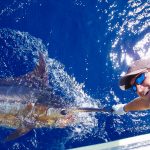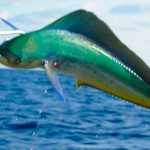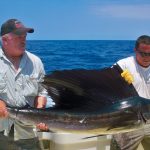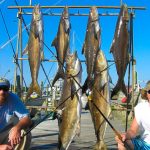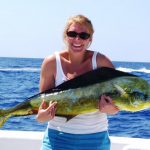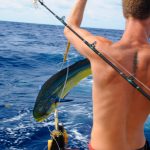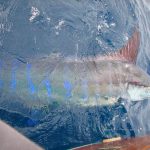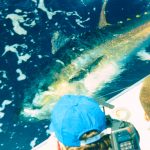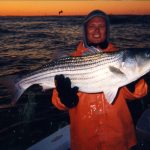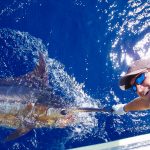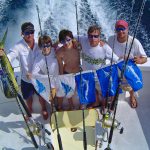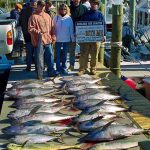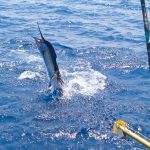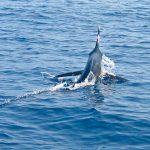The very best guide to charter fishing on the islands

Hatteras and Ocracoke islands are home to some of the oldest and most experienced charter fishing fleets on the East Coast. The islands have had a long and rich fishing history— Hatteras even got a nod in a Marilyn Monroe film—and they continue to be among the most legendary fishing destinations in the United States.
If you’ve never been fishing off Hatteras or Ocracoke, it’s definitely worth looking into. The variety of trips, boats, captains, and species of fish available is quite impressive, and there are options that can accommodate almost any budget or interest.
That said, with so many options available, choosing the right charter can be a daunting task, especially for first-timers. To make it a little bit easier, The Island Free Press has compiled a guide to Hatteras and Ocracoke charter fishing. With answers to frequently asked questions, information on everything from choosing a boat to cleaning your fish, advice on making your trip more enjoyable, and pictures to rouse your inner angler, this guide is designed help get you off the docks and on the water.
Part 1: I want to go fishing. What are my options?
If you’ve never been fishing you should know that you have a lot of options. Everything depends on when you’re coming to Hatteras or Ocracoke, what you want to catch, how much money you want to spend, how long you want to fish, and how many people you want to take with you.
When should I go and what can I catch?
The seasons dictate what’s available to island visitors, and summer offers the most options—more stores and restaurants are open, more captains and trips are available, and the variety of species you can catch is wider. From May to July, you can catch just about anything off Hatteras or Ocracoke. As one captain put it, “Within 12 miles of Cape Point, you can catch anything from a bluefish to a blue marlin.”
But—you can’t catch them all on the same trip or even the same boat.
Some captains troll offshore for large gamefish—marlin, tuna, wahoo, and dolphin—and their boats are designed and rigged-up for that purpose. On the other hand, some captains target the smaller species that live inshore, on wrecks, or in the sound. These include bottom fish (snapper, grouper, sea bass, etc.), Spanish mackerel, bluefish, trout, and flounder. In addition, there are some species, such as cobia and drum, that pass by Hatteras and Ocracoke at certain points throughout the year and are targeted on sight-casting trips.
The chance that you will find a captain who will take you grouper, dolphin, and flounder fishing in the same day is pretty much zero. It’s best to focus on something specific and go from there. If you have no idea what you want to catch, what species are available at certain times, or what kind of fishing you might enjoy, don’t be afraid to ask around. Fishermen like to talk about fishing.
What will it cost?
The price of a trip depends on the captain, the boat, and the type of trip you want. If you want to fish the sound for trout on a small boat, for just half a day, then you can expect to pay considerably less than someone who wants to spend the whole day on a 50-foot sportfishing yacht, chasing billfish in the Gulf Stream.
As a rule, a full-day trip will cost more than a half-day, and an offshore trip will cost more than an inshore.
So, full-day, offshore trips will be the most expensive across the board—they’re also your only option for catching “the big ones.” Prices, on average, range from around $900 to $2,000. Full-day, inshore trips are less expensive, ranging from round $500 to $1,000. Half-day trips have the widest price range, and can cost anywhere from around $300 to $900, depending on where you go and the size of the boat.
Sound fishing trips are less common, with only a handful of captains at each marina offering them, and they fall on the lower end of the half-day, inshore spectrum.
If you will be fishing alone, then by far the most economical options are make-up and headboat charters, which range from around $100 to $250 per person.
In addition, mates work for tips, so when budgeting, you should figure an additional 15 to 20 percent for a gratuity. Also, you may want to consider that almost all captains and marinas require a deposit—either a fixed amount or a percentage of the trip cost—as well as the fact that some marinas offer a discount for paying in cash.
Offshore, inshore, full-day, half-day, make-up, headboat…what?!
It’s not as complicated as it sounds. Without getting too specific, an offshore trip will take place in or around the Gulf Stream—the warm-water current that passes 15 to 25 miles off Hatteras—and anything inside the Gulf Stream will be considered inshore.
Full-days and half-days are pretty much exactly what they sound like—full-day trips last the majority of the day (around nine or ten hours) and half-day trips usually last about four-and-a-half or five hours.
In general, regardless of the marina, most charters leave the dock somewhere around 6 a.m., though some captains may opt to leave slightly earlier or later. If you book a full-day, you can expect to be back on land around 4:30 or 5 p.m.
If you want to book a half-day charter, most captains will give you the option of a morning or an afternoon trip. If you can, take the morning trip. The water is usually calmer and the fishing seems to be a little bit better. Plus, you’ll be home around 11 or 11:30 a.m.—plenty of time to take a nap on the beach! If you prefer an afternoon trip, you can plan to leave around noon and return around 4:30 or 5 p.m.
Make-up and headboat charters are arranged and paid for on a per-person basis. Both are economical options for individuals, and headboats are pretty much the only way to accommodate a group with more than six members.
If you want to fish and it’s just not practical to book the whole boat, make-up charters can be a good idea. You give your name, preferred dates, and contact information to either the marina or individual captains, and they will try to pull six people together to book the boat. The cost of the trip is distributed equally among party members, and each captain has a way of fairly allotting the catch.
Make-up charters are something of a gamble—you won’t necessarily know who you’ll be fishing with, and there’s always a chance that the trip won’t come together. In addition, your options for a trip are slightly limited. Not all marinas and captains offer make-up charters, and, with few exceptions, they are available only for full-day trips.
Headboats—so called because you pay “per head”—offer more flexibility and are generally cheaper. They are large boats that are licensed to carry more than six people (the maximum number that most other charter boats can carry).
There are currently several headboats on both Hatteras and Ocracoke islands..Like make-up charters, there are some drawbacks to headboat fishing. Because of their size and the number of people they carry, headboats are less specialized than other types of charter boats. Most of them target only inshore and bottom fish.
However, unlike make-up charters, headboats offer both full and half-day trips, and some offer evening cruises in the summer—for those who don’t necessarily want to spend all day fishing, but would like to take a boat ride.
How do I get more information and book my trip?
As it is true with most things these days, when it comes to getting more detailed information about Hatteras Island fishing, the Internet is your friend. All of Hatteras Island’s major marinas and Ocracoke marinas have websites that provide descriptions of the fleet, rates and booking information, and fishing reports with pictures. Each marina’s website lists contact information, so if you don’t know what you’re looking for, you can call or e-mail the marina for guidance.
In addition, most captains have their own websites, which provide phone numbers and e-mail addresses, descriptions of their boats, the types of trips they run, photos from past trips, and recent fishing reports. If you have questions, don’t hesitate to call the captain and ask. It’s much better to do that than to book a trip without knowing if it’s what you really want. Moreover, if you deal directly with a captain, he or she will mostly like be happy to recommend another captain who can meet your needs if necessary.
When it comes to booking, your safest bet is to go through the marina. Some captains take reservations directly from customers via phone or e-mail, so if you know which captain you would like to book, you approach it that way. But, if you don’t have a preference, or you aren’t sure what you want, the marina can save you a lot of time and trouble.
Each marina will have different policies and procedures, but be aware that when you book a trip, you will need to make a deposit. Even if you schedule a trip directly through a captain, you should still be prepared to put something down. Similarly, there is no standard refund policy, so check with whoever books your trip for details.
Part 2: I’ve booked my trip. Now what?
Think of booking a fishing charter as buying a plane ticket (except without the paying upfront and in-full part). Basically, barring some emergency or drastic change of plans — in which case, you would need to let someone know as soon as possible — you do nothing but get really excited until a day or two before your trip. At that point, you need to call the captain (or marina) and confirm.
As with flights, details, such as departure time, may change slightly from day to day. For example, maybe the website said you should be at the boat by 6 a.m., but the captain wants to leave at 5:30 to beat the crowd to the fishing grounds or maybe the weather has turned ugly and you won’t be able to go. A lot can change in a Hatteras day, so don’t forget to call your captain.
What should I wear?
Wear something comfortable and adaptable. If you hate the feeling of wet denim, then don’t wear jeans (or jean shorts). If you get cold easily, then consider bringing a sweatshirt or a jacket—even in the middle of summer, the morning ride can be quite chilly. And, obviously, dress for the weather. If it’s raining, take a raincoat. If it’s 95 degrees in the shade, wear something loose and breathable—or maybe a bathing suit. And for safety reasons, you should always wear shoes.
Also, don’t wear anything that can’t get ruined, because there is always the possibility that it will. You will get wet, and at the end of the day, you will be crusted with salt, and if you catch a fish, there will be blood, and if someone gets seasick, there will be vomit. So keep that in mind when you’re getting dressed.
What should I bring?
The captain will provide all the bait, tackle, and ice necessary for the trip. Everything else will be your responsibility—excluding safety equipment. The following list is not exhaustive, but it should cover the essentials:
- Any and all food and drinks you will want (Note: It is a good idea to bring your own cooler, with ice, to keep these items cold)
- LOTS of water
- A hat and/or sunglasses
- A sweatshirt or a jacket
- A change of clothes (This may seem unnecessary—until you rip your pants or get soaked by some rogue wave.)
- Sunscreen
- A camera
- A towel
- Any medicine you may need. It is very important that you let the captain know of any serious medical conditions you or a member of your party may have and how to address them.
Is there anything else I should know?
There are a few additional things you may want to keep in mind when preparing for your trip.
First, be aware that you could get seasick. Even if you can read a book while simultaneously eating a chili dog and chugging a beer on that crazy teapot ride, there is no guarantee that you will not get seasick.
It’s a whole different ballgame 20 miles offshore, and I can promise you that, after you’ve spent several hours emptying the contents of your stomach over the side of a boat that won’t stop rocking, you’ll spiral downward into the most diabolical form of vertigo imaginable, and you will beg for the merciful hand of death. It will not come.
Instead, someone will hand you a box of crackers and a fishing rod, and you will curse the day you decided to book a fishing trip.
Seriously though, seasickness can ruin your trip, so if you don’t know, don’t risk it. There are all kinds of preventative strategies—everything from prescription-strength anti-nausea medication to wristbands that keep steady pressure on specific points in your wrists—and any of them would be better than getting sick.
Clearly, I have some experience in this area, so I will pass along the best advice I’ve received over the years:
- Take Dramamine, but take it the night before your trip. Otherwise, you might sleep through the whole thing
- No matter how badly you want to go lie down in the cabin, don’t do it. It’s the worst place to go. Stay outside and take deep breaths
- Take some sort of bland chips or crackers with you on the boat (Cheez-Its work best for me), and if you start feeling sick, start eating. I cannot tell you why or how this works, but the advice came from a very salty captain and has proved most helpful in the past
- You will be able to tell the difference between “Oh, I feel nauseated,” and “Holy moly, I am going to vomit.” When you reach the latter point, just let it fly. You will feel better when it’s over.
A second thing to consider is that, while most items you will need or want can be purchased at any of the marina stores the morning of your trip, there is one crucial exception—alcohol.
North Carolina law forbids the sale of alcohol before 7 a.m. (noon on Sundays), so if you want to take alcohol with you, be sure to get it the day before. Also, if you choose to take alcohol on the boat, get it in cans or plastic containers whenever possible. Broken glass can cause injuries.Third, understand that your trip could be cancelled due to bad weather. Just be aware that your idea of bad weather and a fisherman’s idea of bad weather may be completely different.
Ultimately, the wind speed and direction is more important than anything else, so if it’s raining cats and dogs but the water is calm, you’ll probably go fishing. On the other hand, if it’s sunny and warm and there’s not a cloud in the sky, but there’s a 20 knot south wind blowing, you’ll probably be sitting at the dock. Basically, when the captain makes a decision based on the weather, don’t argue with him.
And, lastly, there’s a saying around the docks that goes, “That’s why it’s called fishing, not catching.” Keep that in mind on your trip, because there is always a chance that you will spend 10 hours on the water and come home with nothing but a sunburn and an empty bag of chips. That’s just the nature of the beast.
And because fishing is heavily regulated, you may not get to keep everything—or anything—you catch. If the captain tells you to throw something back, then throw it back. He can face strict penalties and hefty fines for illegal fish.
That said, there’s also a chance that you will come home with more fish than you know what to do with. A word to the wise: In that case, get your fish cleaned by professionals.
Most of the marinas offer a fish cleaning service, and most charge around $1 per pound. Unless you are a seasoned fish cleaner yourself, it will be well worth your time and money to take your fish to someone who knows what they are doing. What a shame it would be to waste the fruits of your labor.


